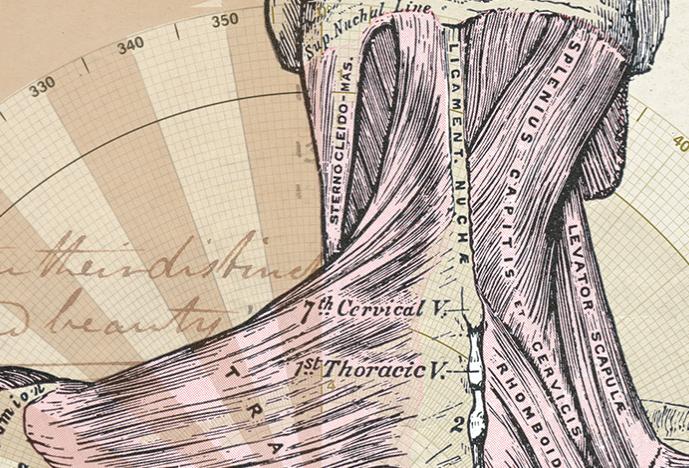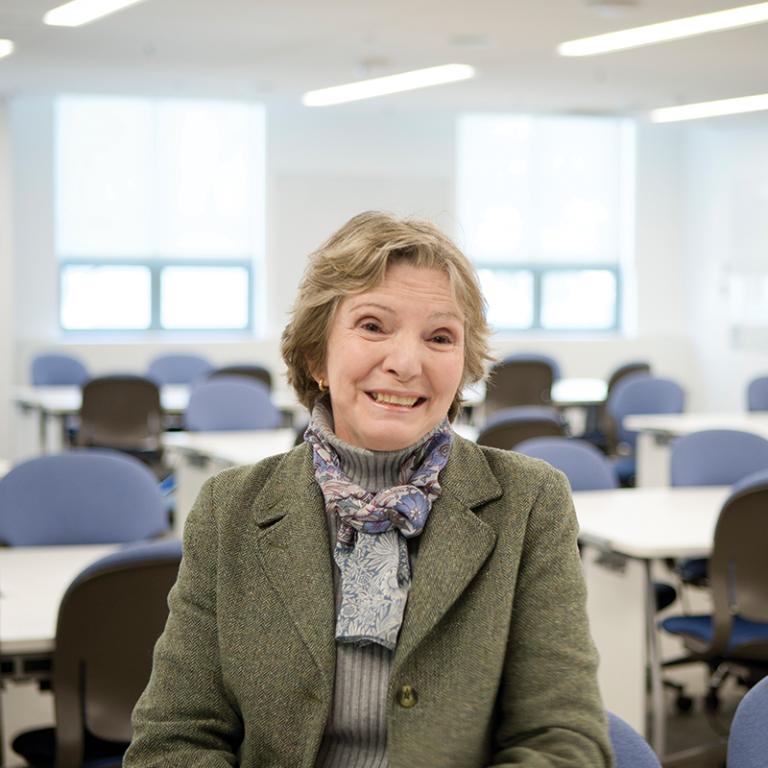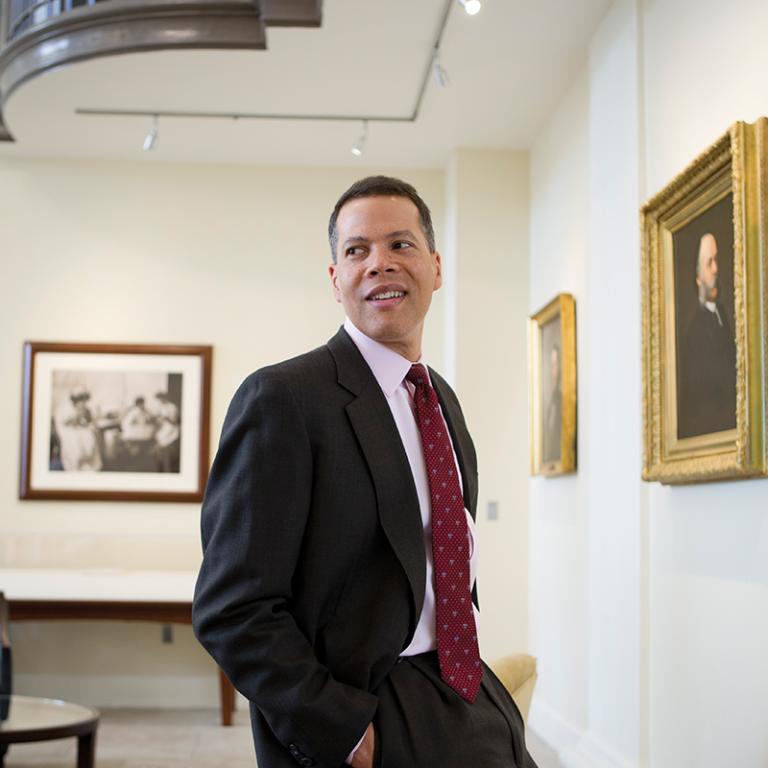Tinker, Tailor, Surgeon, Trainer
Anatomy courses allow young surgeons to gain experience and perspective
- 6 minute read
- Feature

A thoracotomy is not something a surgeon in an emergency department does every day. When, as a resident, Noelle Saillant was faced with having to perform the procedure, she realized the conditions were not ideal: the lighting wasn’t good, the room was less than sterile, and the patient was in arrest after having stabbed herself in the heart. Although the attending had been called, Saillant, now an HMS instructor in surgery at Beth Israel Deaconess Medical Center, knew she had to act before he arrived.
Her brain began moving through the procedure: Open the chest. Open the heart and release the blood surrounding it. Repair the damaged ventricle. Cross-clamp the aorta. Restore and stabilize the blood pressure.
A surgeon needs to be a creative problem solver, a technician, and a scientist. Experience builds those skills, but for surgeons new to the profession, it’s valuable to gain experience not only in the operating room but also outside that pressured setting. At HMS, the opportunity to learn away from the hospital is available in a surgical anatomy class as well as in weeks-long sessions that concentrate on skills development. These programs allow students and residents to develop judgement and learn how to communicate compassionately while also refining their skills in using surgical tools to cut, repair, and sew.
Dry Run
Only two days before she needed to perform the thoracotomy on a real patient, Saillant had practiced the procedure on a cadaver in the School’s advanced surgical anatomy course. During that training, she had opened the thoracic cavity, taken the time to explore the anatomy in the chest cavity, found where the phrenic nerves lay so she wouldn’t accidentally cut them, learned the vital skill of cross-clamping the aorta so that the brain continues to get blood, and finally, evaluated the heart’s anatomy.
So, when confronted with the situation in the emergency department, Saillant says, “I just knew what to do. And I knew how to do it.”

According to Saillant and Trudy Van Houten, an HMS clinical instructor in radiology who directs or co-directs many of the School’s anatomy courses offered to medical students and residents, allowing surgical residents to focus on anatomy in an academic setting is a newer approach in their training. Even though working on a living patient is different—a cadaver has no blood and its tissue has a texture that differs from that of living tissue—the training is valuable. In the class, residents can move the layers of tissue, muscle, nerve, and bone at a pace and with a level of scrutiny that surgeons would never be able to accommodate when operating on a living patient. In addition, a spirit of inquiry pervades the course, and participants are encouraged to question.
Hand-Eye Communication
“Surgical approaches are never more extensive than they are in the anatomy lab,” says Van Houten. She has designed and written laboratory manuals that include anatomical background information and dissection sequences based on surgical approaches and clinical standards.
The surgical anatomy dissection course has proved beneficial to residents’ competence and confidence. A 2016 study in the Journal of Surgical Research, authored by Van Houten and colleagues at Brigham and Women’s Hospital, reported that second- and third-year surgery residents who had performed such dissections showed greater proficiency and reported higher confidence in their surgical ability than those who had received access to course materials, including laboratory manuals and links to videos, but had not performed surgical dissections on cadavers.
Techniques can be taught and then honed, but according to Van Houten, it is often possible to discern which residents have the combination of skill and aptitude needed to become good surgeons. Promising residents have a knack for revealing and manipulating the layers of tissue, organ, and bone; an eye for distinguishing the body’s structures as well as the ability to envision the anatomy beyond what they see; the cognitive skills to plan and make visual-spatial connections; and a drive to question and think critically about what they are learning.
Both Saillant and Van Houten speak of the continuous and layered teaching and learning that make up the career of a surgeon. At HMS, attendings teach residents, residents teach interns, and attendings, residents, and interns teach medical students.

Needlework
According to George Dyer ’02, the director of the Harvard Combined Orthopaedic Residency Program, residents can also practice their technical skills in the simulation labs at the program’s four hospitals: Beth Israel Deaconess, Boston Children’s Hospital, Brigham and Women’s, and Massachusetts General Hospital. During a month-long boot camp, residents are relieved of their daily responsibilities and given time to focus on improving their surgical skills. During a session at Brigham and Women’s STRATUS (Simulation Training, Research, and Technology Utilization System) Center, for example, participants sutured incisions in pigs’ feet. Dyer, who also is an HMS assistant professor of orthopedic surgery at Brigham and Women’s, explains that sewing is one of the simplest things that a surgeon does besides cutting. In the simulation lab, the residents are able to perfect that skill in a setting that provides “more of a learning experience than a task to be learned in process,” he says. The instructors tailor their comments; they might direct one resident to move his hand ten degrees, suggest that another orient her head differently to better view the surgical field, or encourage all to hold their suture needles at a particular angle. “Deliberate practice makes more efficient, safe, and effective habits as a surgeon,” says Dyer.
Make a Note
Although the steepest part of the learning curve for a surgeon occurs during residency and the first years of practice, Dyer says improving one’s surgical skills is a lifelong endeavor. As many surgeons do, Dyer keeps a journal; one from his days as a resident is filled with his drawings and notes on various surgeries. Journaling, he says, gives him the opportunity to do a surgery three times: once in his head to prepare, once with the patient, and once again afterward, when he re-creates and revisits his actions.
Mortality and morbidity conferences, the review sessions held for surgical staff, are a hallowed tradition, according to Dyer. M&Ms, as the sessions are colloquially called, bring staff together to review all surgical cases that had complications. This systematic approach to tracking patient outcomes traces its roots to Ernest Amory Codman, Class of 1895, and the surgical evaluation meetings he initiated at Mass General in the early 1900s. As then, selected cases with morbidities that have teaching value are highlighted. Today, all deaths are also discussed. Dyer says these sessions are the most important thing surgical groups do to maintain quality assurance and the rigor of training. Sometimes, he says, errors can be seen only in retrospect. By sharing their cases, surgeons pass along lessons and benefit from one another’s experiences, all to improve skills and patient outcomes.
Van Houten has long been impressed by the community surgeons create. “They’re enormously supportive of each other in situations most of us can’t even imagine encountering.”
Bobbie Collins is the editorial production coordinator in the HMS Office of Communications and External Relations.
Images: Mattias Paludi/Henry Gray/public domain (top); John Soares (portraits)